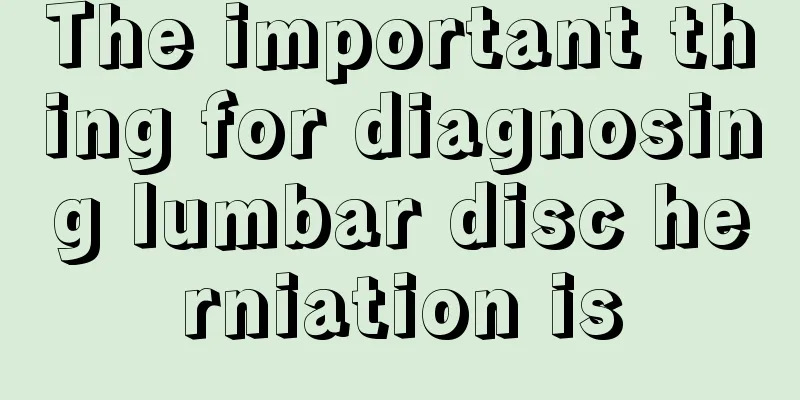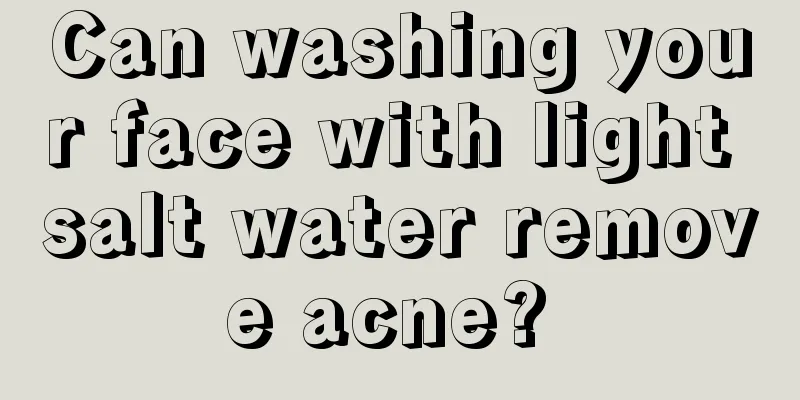The important thing for diagnosing lumbar disc herniation is

|
Most people will experience lower back pain, especially after bending over for a long period of time, the pain will gradually intensify. Although lumbar disc herniation is a common lumbar disease, not all lower back pain is caused by lumbar disc herniation. Therefore, if you want to diagnose a disease like lumbar disc herniation, you still need certain diagnostic basis. So what is the basis for diagnosing a disease like lumbar disc herniation? diagnosis:
When the lumbar disc herniates, the movement of the waist is restricted, the physiological curvature of the waist becomes straightened, or scoliosis of the waist occurs. The diseased intervertebral disc usually causes tenderness and percussion pain next to the spinous process of the corresponding vertebra in the posterior lumbar region. The pain radiates to the buttocks, back of the thigh, and outer side of the calf, indicating compression of the sciatic nerve, with the lesions at L4/5 and L5/S1. If the pain radiates to the front of the thigh, it indicates compression of the femoral nerve, with the lesions often at L2/3 and L3/4. Check the sensation, muscle strength, and muscle tension of the lower limbs. Decreased superficial sensation on the dorsum of the affected limb indicates L4/5 disc herniation, while decreased superficial sensation on the plantar surface indicates L5/S1 disc herniation. If the dorsiflexion of the big toe of the affected limb is weak, it often indicates L4/5 disc herniation. If the plantar flexion of the big toe of the affected limb is weak, it indicates L5/S1 disc herniation. Check the tendon reflexes of the lower limbs. If the Achilles tendon reflex is weakened or disappeared, it indicates that the lesion is in the S1 segment. If the knee tendon reflex is weakened or disappeared, it indicates that the lesion is in the L4 segment. Some typical physical examination tests:
(1) Straight leg raising test. The patient lies supine on the bed with both lower limbs straight and one leg passively lifted off the bed. If no pain occurs when the leg is raised to more than 60 degrees, it is considered negative; if pain occurs when the leg is raised to less than 60 degrees, it is considered positive. If the result is positive, an enhanced test can be performed. The affected limb is lowered 5°. If the pain disappears and the ankle joint is hyperextended, the pain reappears. This indicates a positive enhanced test. This is pain caused by compression of the nerve root, which pulls on the sciatic nerve. A positive result indicates sciatic nerve compression and disc herniation at L4/5 or L5/S1. (2) Healthy leg raising test: The patient lies supine on the bed. When the healthy leg is straightened and raised, pain also occurs in the other leg, indicating a positive healthy leg raising test. This is caused by a larger intervertebral disc herniation and more severe compression symptoms. A positive result indicates sciatic nerve compression and disc herniation at L4/5 or L5/S1. (3) Neck flexion test: The patient sits with both legs straight and the patient is asked to flex his neck. If it causes radiating pain in the legs, it is considered positive. (4) Supine abdominal extension test: The patient lies on his back and lifts his hips and abdomen so that his hips and back leave the bed. A positive result is the presence of radiating pain in the lower limbs. (5) Femoral nerve traction test: The patient lies prone with the affected knee straightened. The affected calf is lifted up so that the hip joint is in a hyperextended position. A positive result is detected if pain is felt in the front of the thigh. A positive result indicates compression of the femoral nerve and herniated disc at L2/3 or L3/4. (6) Heel-butt test: The patient lies prone with the affected knee flexed and the heel against the buttocks. A positive test is considered if pain is felt in the front of the thigh of the affected limb. A positive result indicates compression of the femoral nerve and herniated disc at L2/3 or L3/4. Related imaging examinations:
X-ray examination can be used to understand the physiological curvature of the lumbar spine, bone hyperplasia, whether there is stenosis of the intervertebral foramen, whether there is vertebral slippage, lumbar stability, and whether there is dislocation of small joints. CT examination: to understand whether there is calcification in the waist, the size and direction of the disc herniation and the calcification of the disc, the degree of stenosis of the spinal canal, and whether there is calcification in the yellow ligament and posterior longitudinal ligament. MRI examination: It can be used to understand whether the lumbar spinal canal is narrowed, and the size and direction of the intervertebral disc herniation. MRI examination is superior to CT in some aspects (spinal canal stenosis, yellow ligament hypertrophy, nerve compression, intervertebral disc herniation, and free disc). It has now become the main diagnostic basis and examination method for lumbar disc herniation. However, it is more expensive than CT scan. Some patients who have internal fixation devices of unknown nature in their bodies or have recently undergone cardiac stent interventional surgery are not suitable for MRI examination. Myelography is used to determine whether the lumbar spinal canal is narrowed. However, because it is invasive and a few people are allergic to contrast agents, it has now been replaced by MRI examinations. Treatments for lumbar disc herniation include conservative treatment, interventional treatment, minimally invasive surgery, and open surgery. Conservative treatment is effective for mild disc herniation or bulging. Current conventional conservative treatments include: 1. Rest in bed. For most patients with mild symptoms and no prominent CT and MRI findings, the symptoms can be relieved by bed rest. The principle is that when resting in bed, the pressure on the intervertebral disc is 0, thus giving the damaged intervertebral disc a certain amount of time to recover. 2. Traction. The purpose of using a traction bed to pull the waist is to relieve the pressure on the intervertebral disc, reposition the protruding intervertebral disc, and relieve the compression of the nerve roots. 3. Physical therapy. Fumigation, acupuncture, electrotherapy, infrared irradiation, heat therapy, massage and other methods all have basically the same purpose, which is to relieve the tension and spasm of the patient's muscles, rather than to cure them; 4. Drug treatment. The compression of nerves after intervertebral disc herniation is the direct cause of neurological symptoms. The protruding nucleus pulposus can produce some inflammatory substances, such as prostaglandins, arachidonic acid, etc. These inflammatory substances can cause nerve root edema, thereby aggravating neurological symptoms. The main purpose of drug treatment is dehydration, swelling reduction, inflammation reduction, pain relief and nerve nutrition. The main drugs are: 1) Analgesics: Non-steroidal anti-inflammatory drugs, such as etoricoxib, diclofenac, celecoxib, indomethacin, etc., mainly taken orally. 2) Dehydration and swelling-reducing drugs: mannitol, sodium aescinate, glycerol fructose, etc., mainly administered intravenously. 3) Anti-inflammatory: mainly glucocorticoids, such as prednisolone, dexamethasone, methylprednisolone, hydrocortisone, etc., which can be applied intravenously, orally, or by local block injection. 4) Nerve nutrition drugs: Oral: methylcobalamin tablets, extract tablets of inflammatory skin of rabbits vaccinated with vaccinia vaccine; intravenous medication, methylcobalamin for injection, extract of inflammatory skin of rabbits vaccinated with vaccinia vaccine for injection, sodium monosialotetrahexanoylganglioside for injection. |
>>: Judging the acute stage of lumbar spine
Recommend
Can the oil still be consumed after it expires?
In recent years, gutter oil has been rampant in v...
Why don’t I gain weight no matter how much I eat
Some people are born with the ability to never ga...
Will brain cancer cause amnesia and convulsions?
Late stage brain tumors can lead to space-occupyi...
How to treat alveoli?
The treatment of alveoli cannot be ignored, but t...
Is it serious to find out that the liver cancer is 5cm? What is the best treatment for liver cancer?
Liver cancer is a malignant tumor that occurs in ...
What are the folk remedies for treating gallstones?
Gallstones are a relatively common disease in my ...
How to preserve black tea
The black tea sold on the market is all vacuum-pa...
How to wash off printer ink on clothes
Oil stains on clothes are a common phenomenon in ...
What should I do if I have acute pharyngitis?
Acute pharyngitis is a type of viral pharyngitis ...
What is Chancroid Disease
Chancroid is actually an infectious disease cause...
How to clean nipples before breastfeeding
Many mothers always like to clean their nipples b...
Are nodular goiter and thyroid nodule the same?
The human thyroid gland is directly related to th...
What are the symptoms of high uric acid?
The problem of high uric acid levels must never b...
How to prevent brain tumors
The best way to reduce the harm to brain tumor pa...
What tests are needed to diagnose prostate cancer
Clinical examination can help doctors and patient...









